|
The back can be broken down into the upper back, and
the lower back. After the thigh and buttocks, the back muscles are the
largest in the body. There are three main muscle groups in the upper
back, the trapezius, latissimus dorsi (lats), and erector spinae. The
trapezius is responsible for pulling the shoulders upward and backward.
The latissimus dorsi pulls the arms backward and downward. The erector
spinae act to straighten up the spine from a bent position.
The trapezius is worked during any exercise which
involves lifting the shoulders. The includes shrugs, upright rows, and
certain presses.
The latissimus dorsi (lats) are developed by cable
pulldowns or chins.
The lower back, which contains the muscles on either
side of the spine (erector spinae) is strengthened with dead lifts, bent
over rows and hyperextensions. Lower back muscles work together with
the oblique abdominal muscles and the quadratus, to support the spine and
give greater range of motion. Realize that the muscles of the lower
back function differently than many other muscles in the body, and are
mainly stabilizers, giving the body support and stability.
Start slow, and build upon your progress. Below
are listed a number of exercises which can be used to strengthen the back.
The are labeled by levels of difficulty (easy, intermediate, advanced).
Your workout should be fun. If it hurts, stop.
Good Mornings (advanced)
Stand straight up with your legs about shoulder width
apart. Place a light bar or broom handle on your back behind your head
keeping both hands on the bar. You are going to bend over at the waist
keeping your legs straight but with a slight bend at the knee. Your body
will end up close to a 90-degree angle. Make sure to keep your chest out and
shoulders back when performing this exercise. Always keep your head up and
try not to look down.
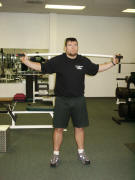
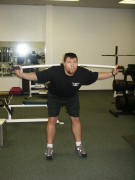
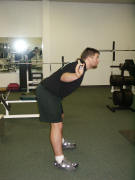
Spider Good Mornings (advanced)
Almost the same as a good morning except now you are cradling something in
your arms to add some resistance. The same rules apply to this at it does
with the good morning. Remember to keep the weight close to your body.
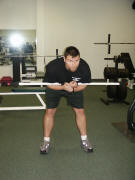

Pelvic tilt (easy)
Lay flat on your back with your legs bent and your
hands at your sides, right next to your butt. You will keep your hands,
feet, and upper back on the ground while raising your butt and pelvic area
into the air.
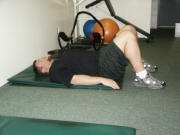
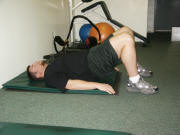
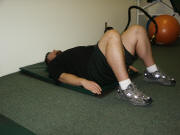
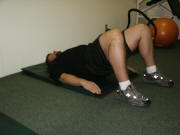
Supermen (easy)
Lay flat on your stomach with arms fully extended above
your head. Here you will simultaneously raise your arms and legs into the
air with your stomach and pelvic region are still touching the ground.

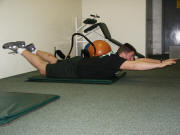
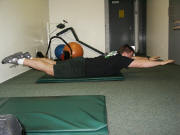
Alternating supermen (easy)
Laying flat on your stomach with your arms extended
above your head you will raise your left arm and right leg at the same time.
Alternate and do the same for the other side.
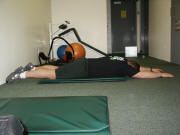

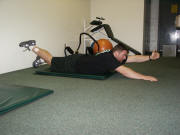
Stiff leg dead lift (intermediate)
This is done similar to the double toe touch except you will have a
lightweight in your hands. You will hold the weight and proceed down as far
as you can comfortably go and proceed back up to the standing position. It
is important to keep the weight very close to your body throughout the
entire range of motion. Keep your chest out and shoulders back. You do not
have to go all the way down to your toes with this exercise.
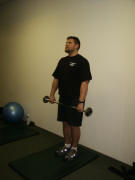
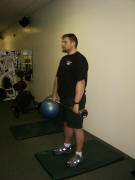
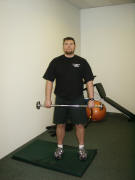
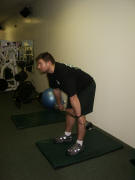
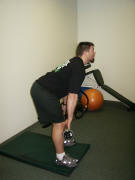
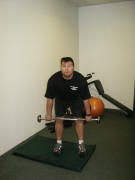
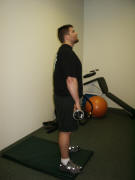
Twists (easy)
It is best to do these seated. Grab a broom handle or
light bar and place it behind your head. Sit up straight with your chest out
and shoulders back and twist to your right as far as you can comfortably go
and then proceed to your left. It is a similar motion to when you check your
blind spot when driving.
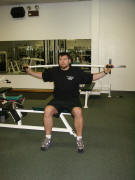
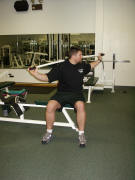
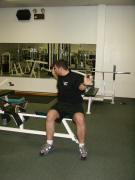
Side bends (easy)
Grab onto something light like a dumbbell or a purse.
Place it into your right hand. Place your left hand on your head. Stand
straight up with chest out and shoulders back and drag the weight down
towards your right knee and then stand back to the start. It is important
not to lean forward when doing this.


Hammer Low Row (intermediate)
Sit down on the seat with your legs on each side of
seat. (Straddling it.) Place stomach and chest firmly against the seat. If
you are doing this alone then you may have to grab one handle then grab the
other one. Individuals with short arms will not be able to grab both at the
same time. It is best to have someone lift them to you if possible. Once
you have the handles in both hands you should now sit straight up with your
chest sticking out. Then you will pull the handles in towards your stomach
and chest. Slowly lower the weight down to the starting position and repeat.
When you are finished you can lower each handle down or you can just drop
them. Most of these machines have thick rubber pads that allow you to drop
the weight with out damaging anything.

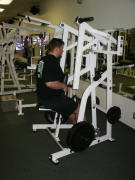
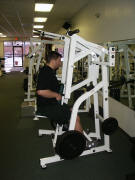
Hammer High Row (intermediate)
Sit down on the seat with your legs on each side of
seat. (Straddling it.) Place stomach and chest firmly against the seat. If
you are doing this alone then you may have to grab one handle then grab the
other one. Individuals with short arms will not be able to grab both at the
same time. Once you have the handles in both hands you should now sit
straight up with your chest sticking out. Then you will pull the handles in
towards your chest. Slowly lower the weight up to the starting position and
repeat. When you are finished you can raise each handle up or you can just
drop them. Most of these machines have thick rubber pads that allow you to
do this.
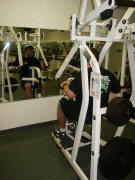

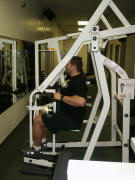
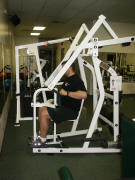
Seated Row
Place feet on the designated footpads with a good deal
of bends in the legs. To get this exercise started you will pull back with
your legs while keeping your chest out and back flat and arms straight.
Straighten your legs until they are almost straight. This is the starting
position. Keep your stomach tight the entire time you perform this exercise.
Now you will pull the handle in towards your stomach. Imagine that you are
elbowing the wall behind you. When you get the handle to your stomach
contract your upper back muscles hold it for a second and slowly lower down
to the starting position. Individuals that have any serious lower back pain
or have had any severe lower back pain within about 3-4 months should not do
this exercise.


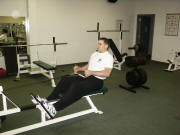
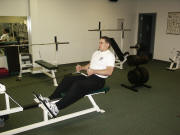
Lat Pull Down
Grab the bar about shoulder width apart and sit down so
that your upper legs are firmly under the supportive roller pads. Now that
you are siting down you should have your arms straight and you should
slightly be leaning back. This is the starting position. Now you will pull
the bar towards your chest touching it at your chest or collarbone area.
When you get it close to your chest pull your elbows back towards the wall
behind you. You do not want to have your elbows in front of you when you are
finished. If your are not flexible enough to get the bar to your chest then
pull it about chin level.
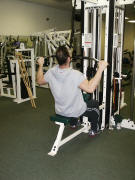
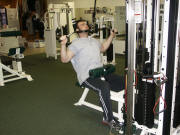
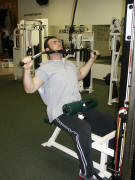
Reverse Hyperextension on a Ball
This exercise may be a little awkward to do because it
requires that you balance yourself while performing this strengthening
exercise. Lay flat on the ball with your belly button in the center of the
ball. Place your hands behind your head and raise your upper body towards
the ceiling pivoting at your waist. Go back to the start position and
repeat. Having someone hold your feet or placing them under something firm
will help with the balancing in this exercise.

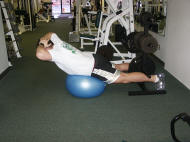
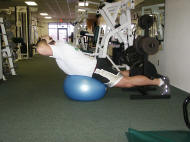
Stretching
Back Strengthening
Abdominals
Legs
Chest
Shoulders
Biceps
Triceps |

